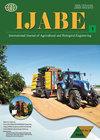Energy use efficiency and greenhouse gas emissions (GHG) analysis of garlic cultivation in Turkey
IF 2.2
2区 农林科学
Q2 AGRICULTURAL ENGINEERING
International Journal of Agricultural and Biological Engineering
Pub Date : 2023-01-01
DOI:10.25165/j.ijabe.20231604.7599
引用次数: 0
Abstract
This study has been conducted with the purpose of determining energy use efficiency and greenhouse gas emissions of garlic cultivation during the 2020-2021 cultivation season in Adıyaman province of Turkey. Questionnaires, observations and field works were performed in 134 garlic farms in the region through simple random method. In garlic cultivation, energy input was calculated as 32103.20 MJ/hm2 and energy output was calculated as 30096 MJ/hm2. With regards to the three highest inputs in garlic production, 46.66% of the energy inputs consisted of chemical fertilizers energy (14979.26 MJ/hm2), 11.29% consisted of farmyard manure energy (3625.71 MJ/hm2) and 10.48% consisted of human labour energy (3363.36 MJ/hm2). Energy use efficiency, specific energy, energy productivity and net energy in garlic cultivation were calculated as 0.94, 1.71 MJ/kg, 0.59 kg/MJ, and −2007.20 MJ/hm2, respectively. The total energy input consumed in garlic cultivation was classified as 27.19% direct energy, 72.81% indirect energy, 35.17% renewable energy and 64.87% non-renewable energy. Total GHG emissions and GHG ratio were calculated as 8636.60 kgCO2-eq/hm2 and 0.46 kgCO2-eq/kg, respectively. Keywords: energy use efficiency, garlic, greenhouse gas emissions, specific energy, Turkey DOI: 10.25165/j.ijabe.20231604.7599 Citation: Baran M F, Demir C, Eliçin A K, Gökdoğan O. Energy use efficiency and greenhouse gas emissions (GHG) analysis of garlic cultivation in Turkey. Int J Agric & Biol Eng, 2023; 16(4): 63-67.土耳其大蒜种植的能源利用效率和温室气体排放(GHG)分析
本研究旨在确定土耳其Adıyaman省2020-2021种植季大蒜种植的能源利用效率和温室气体排放。采用简单随机法对该地区134个大蒜养殖场进行问卷调查、观察和实地调查。在大蒜栽培中,能量输入计算为32103.20 MJ/hm2,能量输出计算为30096 MJ/hm2。在大蒜生产的3大能量投入中,化肥能(14979.26 MJ/hm2)占46.66%,农家肥能(3625.71 MJ/hm2)占11.29%,人力能(3363.36 MJ/hm2)占10.48%。大蒜栽培的能量利用效率、比能、能量生产力和净能分别为0.94、1.71、0.59和- 2007.20 MJ/hm2。大蒜种植消耗的总能源投入中,直接能源占27.19%,间接能源占72.81%,可再生能源占35.17%,不可再生能源占64.87%。温室气体排放总量和温室气体比值分别为8636.60 kgCO2-eq/hm2和0.46 kgCO2-eq/kg。关键词:能源利用效率,大蒜,温室气体排放,比能,土耳其DOI: 10.25165/ j.j ijabe.20231604.7599引文来源:Baran M F, Demir C, eliin A K, Gökdoğan O.土耳其大蒜种植能源利用效率和温室气体排放(GHG)分析。农业与生物工程学报,2023;16(4): 63 - 67。
本文章由计算机程序翻译,如有差异,请以英文原文为准。
求助全文
约1分钟内获得全文
求助全文
来源期刊

International Journal of Agricultural and Biological Engineering
AGRICULTURAL ENGINEERING-
CiteScore
4.30
自引率
12.50%
发文量
88
审稿时长
24 weeks
期刊介绍:
International Journal of Agricultural and Biological Engineering (IJABE, https://www.ijabe.org) is a peer reviewed open access international journal. IJABE, started in 2008, is a joint publication co-sponsored by US-based Association of Agricultural, Biological and Food Engineers (AOCABFE) and China-based Chinese Society of Agricultural Engineering (CSAE). The ISSN 1934-6344 and eISSN 1934-6352 numbers for both print and online IJABE have been registered in US. Now, Int. J. Agric. & Biol. Eng (IJABE) is published in both online and print version by Chinese Academy of Agricultural Engineering.
 求助内容:
求助内容: 应助结果提醒方式:
应助结果提醒方式:


